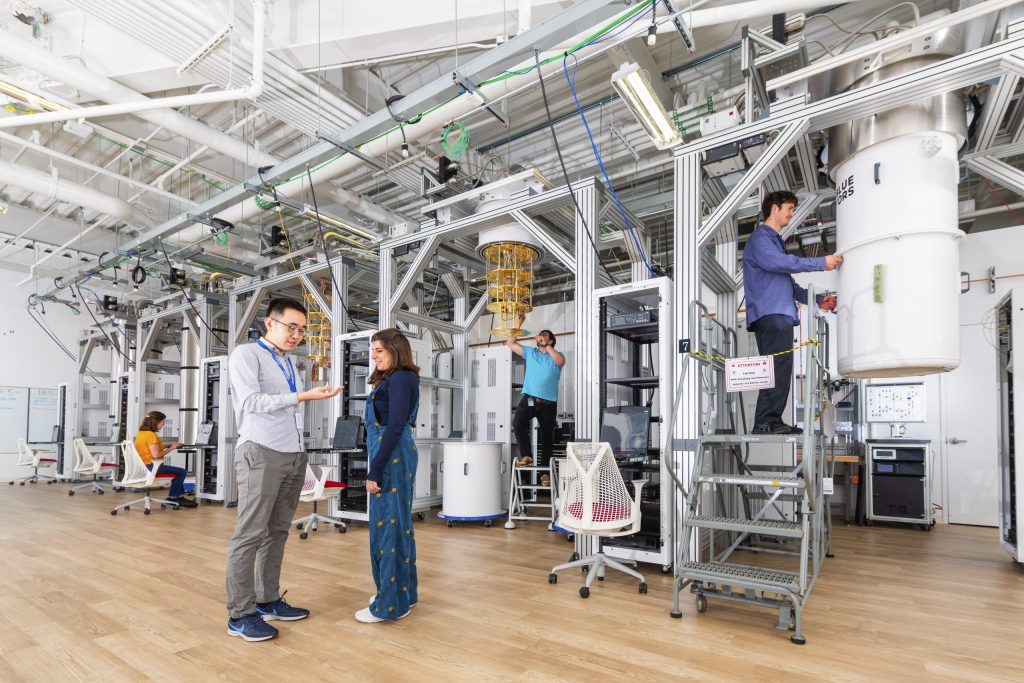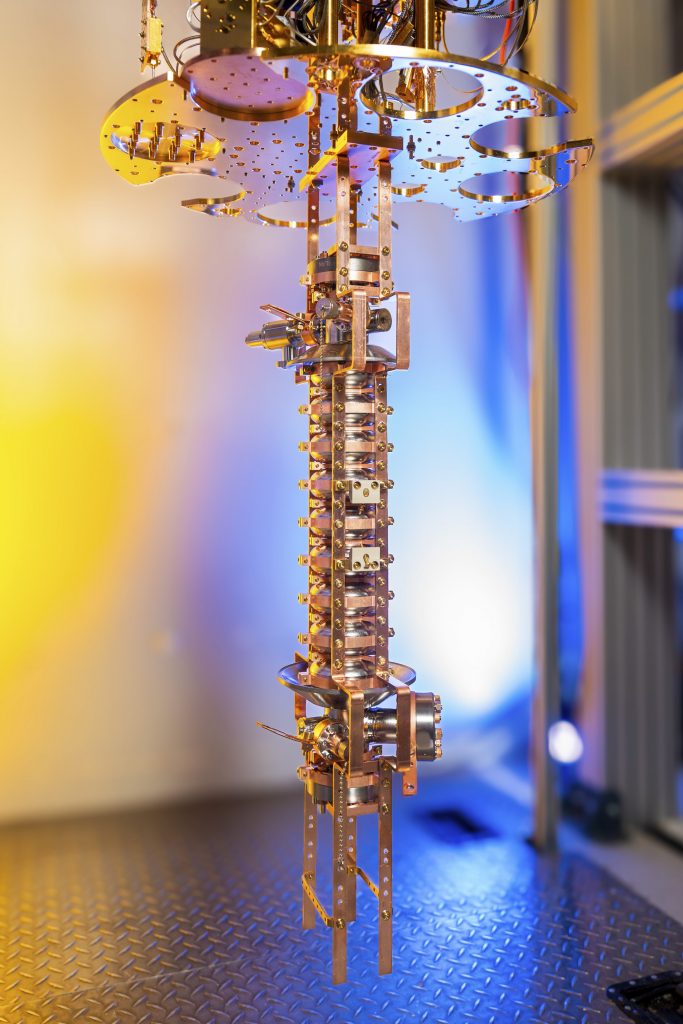The U.S. Department of Energy Office of Science has renewed the Superconducting Quantum Materials and Systems Center (SQMS), hosted by Fermi National Accelerator Laboratory, with $125 million over the next five years to accelerate breakthroughs in quantum information science. The total planned funding is $125 million over five years, with $25 million in the first year and future funding contingent on congressional appropriations.
SQMS, founded in 2020, is one of five DOE National Quantum Information Science Research Centers created under the National Quantum Initiative Act. The center is rooted in Fermilab’s expertise in superconducting radio-frequency (SRF) cavities, materials and cryogenics — technologies originally developed for particle accelerators — and in the lab’s mission to explore the universe at its most fundamental level.

The investment from DOE Office of Science continues to unite more than 300 experts from 43 partner institutions across national laboratories, universities and industry to advance the next generation of quantum computing, communication and sensing technologies.
“In just five years, SQMS has transformed fundamental understanding into tangible progress — from record-setting coherence times to new materials and devices that redefine what’s possible in quantum technology,” said Anna Grassellino, director of the SQMS Center. “This renewal allows us to build on that foundation and take the next leap: moving from discovery to deployment. Together with our partners across national labs, universities and industry, we’re poised to scale quantum systems to a level that will unlock powerful new tools for science, technology and society.”
SQMS will build on major achievements from its first five years to develop world-leading computational capabilities, scalable and resilient quantum systems and technologies that strengthen U.S. scientific and energy leadership.
Pushing the limits of quantum performance
The center strategically complements these strengths through a multidisciplinary collaboration spanning quantum information science, superconductivity, materials science, cryogenics, microwave engineering, computational science and high-energy physics. Together, the team has tackled one of the field’s greatest challenges — extending quantum coherence, the time a qubit can reliably hold information.
Through innovations in materials, fabrication and cavity-based architectures, SQMS has achieved world-leading coherence times and developed the building blocks for its 3D-cavity, qudit-based platforms. The center has also driven progress in quantum sensing, producing record sensitivities and novel methods for dark-matter searches and precision measurements.
Entering a new era
In the next phase, SQMS will use ultra-high-coherence SRF cavities and scalable cryogenics to address some of quantum technology’s most significant hurdles. The program’s goals focus on three major efforts:
Chip-based materials and device breakthroughs
SQMS will pursue new materials and fabrication methods to deliver progressively higher-coherence superconducting devices for cavity-based computing, communication and sensing systems. The center aims to achieve the ambitious goal of 10-millisecond coherence in chip-based transmon qubits — a milestone that will also benefit commercial platforms such as those of SQMS partner Rigetti Computing.

“The SQMS collaboration is driving major progress in understanding the microscopic origins of decoherence in superconducting circuits and detectors,” said Jim Sauls, professor and Hearne Chair of Theoretical Physics at Louisiana State University. “That knowledge not only advances quantum information science, it also deepens our understanding of superconductivity, one of the most fascinating and fundamental states of matter.”
Development of a 100-plus-qudit SRF quantum processor at Fermilab
While most efforts rely on 2D superconducting qubits, SQMS is advancing a 3D cavity-based qudit approach, in which each cavity encodes multiple quantum states. This architecture offers higher connectivity, reduced control complexity and more efficient algorithm implementation. SQMS will build and deploy, in collaboration with partners such as Quantum Machines, a 100-qudit prototype — equivalent in computational space to roughly 500 qubits — within a single dilution refrigerator. The platform will serve as a unique facility for computing and sensing experiments.

Demonstration of the first scalable quantum data-center unit
To enable future quantum data centers with thousands of qubits, SQMS will prototype the cryogenic and microwave infrastructure required for large-scale interconnection. This includes high-fidelity, cavity-based links between multiple IBM quantum networking units and a liquid-helium cryoplant-based, energy-efficient solution for future quantum data centers developed with Maybell Quantum Industries.

“Fermilab and the SQMS Center are pushing the frontiers of cavity science and technology in ways that directly complement IBM’s efforts to scale quantum computing,” said Jay Gambetta, Director of IBM Research and IBM Fellow. “Their work on high-coherence superconducting cavities will ultimately help lay the foundation for the quantum computing internet, where multiple quantum computers operate together as one system, and interface with a network of other quantum computers, communication and sensors. Our initial ambition is to show we can entangle two cryogenic separated quantum computers within the next five years. This kind of collaboration is essential to move the entire field forward — from individual computers to large-scale, interconnected quantum systems that can transform discovery and industry alike.”
Advancing discovery with quantum information science
SQMS breakthroughs will open new frontiers in both technology and science. Planned experiments using SQMS-developed hardware include quantum-sensing searches for dark matter and gravitational waves, precision magnetometry and fundamental tests of quantum mechanics, along with simulations relevant to high-energy and condensed-matter physics.
“INFN is proud to be part of the SQMS collaboration, which unites scientists across continents in the pursuit of the development of quantum technologies which are fundamental for the future of research and of our society,” said Antonio Zoccoli, president of Italian National Institute of Nuclear Physics (INFN). “By combining the strengths of the Italian community in superconducting materials, cryogenics and fundamental physics, we are accelerating progress toward a deeper understanding of nature and new technologies that will benefit society.”
Through this renewed partnership, Fermilab and its collaborators will continue pushing the limits of quantum coherence, scaling and control — shaping the foundation for the next generation of quantum information science and technology.
“The SQMS Center exemplifies how DOE’s national labs bring together multidisciplinary teams to tackle grand scientific challenges,” said Young-Kee Kim, interim director of Fermilab. “Its advances will help secure U.S. leadership in the global race to develop practical quantum technologies.”
SQMS collaborators and partners
SQMS new era collaborators include: Aalto University, Ames National Laboratory, Applied Materials, Bluefors, DESY – Deutsches Elektronen-Synchrotron, Fermi National Accelerator Laboratory, IBM, Illinois Institute of Technology, Illinois Mathematics and Science Academy, Infleqtion, INFN – Istituto Nazionale di Fisica Nucleare, Johns Hopkins University, Kyocera, Lawrence Livermore National Laboratory, Lockheed Martin, Louisiana State University, Maybell Quantum Industries, NASA Ames Research Center, NIST, National Physical Laboratory, New York University, Northern Illinois University, Northwestern University, NVIDIA, Quantum Machines, Rigetti Computing, Royal Holloway University London, Rutgers University, Stanford University, Temple University, Unitary Foundation, University of Arizona, University of Colorado Boulder, University of Glasgow, University of Illinois Chicago, University of Maryland, University of Minnesota, University of Oregon, University of Pisa, University of Southern California, University of Toronto, University of Waterloo and the Universities Space Research Association. The other National QIS Research Centers funded by the DOE Office of Science are the Co-design Center for Quantum Advantage, Quantum Science Center, Quantum Systems Accelerator and Q-NEXT.
Fermi National Accelerator Laboratory is supported by the Office of Science of the U.S. Department of Energy. The Office of Science is the single largest supporter of basic research in the physical sciences in the United States and is working to address some of the most pressing challenges of our time. For more information, please visit science.energy.gov.
Imagine a future where networks of entangled photons, harnessing the unique properties of quantum physics, enable computing and technologies beyond anything we know today.
Researchers at the U.S. Department of Energy’s Fermi National Accelerator Laboratory and the California Institute of Technology are using a special kind of light — called “squeezed light” — they believe can overcome key challenges in building scalable quantum networks.
The cutting-edge research represents essential progress toward building a quantum network that could transform scientific research by connecting powerful quantum computers.
These networks rely on entangled qubits — pairs of quantum bits that share information across distances. In quantum physics, entanglement occurs when two or more particles become linked in such a way that what happens to one affects the other, even if they are far apart.
Researchers are working to generate and distribute entangled qubits across longer distances to build larger quantum networks. However, quantum networks over fiber optic cable face challenges such as signal loss, memory decoherence, and delays inherent to communication technologies widely used today.
A new study led by Fermilab shows the potential of a quantum network protocol that can overcome these challenges by using squeezed light, a special state of light with reduced noise and enhanced sensitivity, to pick up faint signals. This research marks a first step toward increasing the entanglement generation rate, which is a key requirement for large-scale quantum networks.

Scientists use various methods to encode qubits with quantum information. One approach uses photons — packets of light energy that have both wave and particle properties — that scientists prepare in special ways to manipulate and control qubits.
The new method described in the study uses two optical encoding types. The combination helps overcome the weaknesses of each and significantly increases the rate of entangled pair generation over long distances.
To transfer entanglement from one pair of qubits to another, scientists use a process called entanglement swapping. Unlike traditional methods that produce only one entangled pair per swap, squeezed light allows many qubits to become entangled.
“The greater number of entangled pairs per light signal, the greater the entanglement distribution efficiency,” said Alexandru Macridin, a scientist at Fermilab who led this research. “But since entangled qubits readily decay, the entanglement generation rate is very important when you build this kind of thing. The more you create, the better.”
Using the new technique, scientists generate entangled pairs by preparing light at two distant locations. Both light sources are sent to a central site equidistant between them and routed through a beam splitter that separates them into two beams of light, one transmitted and one reflected. The light beams return to the central location, where they recombine and are measured. The laws of quantum mechanics dictate that measurement destroys the light but leaves multiple pairs of long-distance entangled qubits.
The method’s effectiveness depends on the strength of the squeezing, but current technology limits how much can be squeezed.
“I calculated that producing one extra entangled pair requires three decibels of squeezing,” explained Macridin. “This means that no more than three or four entangled qubit pairs can be produced using current technology because it only allows for squeezing up to 15 decibels of light.”
Going forward, the team will explore ways to reduce light loss and other effects from fiber optic cables. They will also work to improve the technology and compare light squeezing with other methods for generating multiple qubits. This research is part of a larger collaborative project led by Fermilab called the Advanced Quantum Network, or AQNET. Funded by the Department of Energy Office of Science Advanced Scientific Computing Research program, AQNET aims to connect a local quantum network at Fermilab with quantum nodes at Argonne National Laboratory, Northwestern University, and the University of Illinois at Urbana-Champaign using optical fiber. The ultimate goal is to build a nationwide quantum network.

“With AQNET, we are now at the stage of our development where our network connections can reach metropolitan-scale distances with fiber optics,” said Fermilab scientist Cristián Peña, who leads the project. “This new protocol is another step toward that goal.”
So far, Macridin and his colleagues have confirmed that the new protocol can improve entanglement distribution efficiency in ideal laboratory settings.
The protocol is also significant because it builds on existing entanglement swapping hardware developed at Fermilab. The hardware can be readily integrated into a wide range of applications, including quantum repeaters — devices that extend quantum entanglement over longer distances and support the development of diverse quantum network designs.
Fermi National Accelerator Laboratory is America’s premier national laboratory for particle physics and accelerator research. Fermi Forward Discovery Group manages Fermilab for the U.S. Department of Energy Office of Science. Visit Fermilab’s website at www.fnal.gov and follow us on social media.
What can neutrinos — particles that are imperceptible to all but the most sensitive devices ever built — tell us about how matter triumphed over antimatter in the early universe? As head-in-the-clouds as this question sounds, real people working on the Deep Underground Neutrino Experiment are developing down-to-earth detectors, infrastructure and processes to run this very ambitious experiment to find out.
The liquid argon-based technology chosen for the DUNE neutrino detectors promises to deliver stunning scientific insights and to be complementary to experiments pursuing similar goals that use the more traditional water-based technology. The U.S. Department of Energy’s Fermi National Accelerator Laboratory is the host for DUNE, in partnership with funding agencies and more than 1,400 scientists and engineers from around the world.

Atoms are mostly empty space with a nucleus in the middle and point-like electrons orbiting around it — like infinitesimal solar systems. The nucleus is held together by a force aptly named the “strong force” and it keeps its electrons in tow by the “electromagnetic force,” the familiar opposites-attract force. These are the two strongest of the four known fundamental forces of nature, and neutrinos are immune to both. They are, however, subject to what is called the “weak force,” which comes into play only if they get very close to a nucleus or an electron, and to gravity, which is negligible for this tiny particle.
Neutrinos — travelling at nearly the speed of light and basically blind to and unaffected by everything around them — therefore fly right through matter as though it’s not even there. Except that every once in a while a neutrino gets within weak force range of an atomic particle and crashes right into it. As in any collision, stuff sprays out — subatomic particles, in this case. DUNE wants to capture this once-in-a-while event in its detectors as many times as it can.
To improve the chances for neutrino interactions to both occur and then be detected, DUNE needs: (a) lots of neutrinos, (b) shielding from cosmic rays that would otherwise drown out the neutrino signals, and (c) lots of target material – the denser the better.
The Long-Baseline Neutrino Facility at Fermilab is building a beamline to send a prodigious flow of neutrinos (that’s part “a”) to DUNE’s two neutrino detectors, a smaller near detector at Fermilab, and a gigantic, modular far detector 800 miles downstream. DUNE’s far detector modules will be constructed and installed in South Dakota in a laboratory that is a mile underground (that’s “b,” the earth above the detector will absorb the cosmic rays). Finally, each detector module will be filled with kilotons of a quite well-endowed material, liquid argon (“c”).
In a detector known as a LArTPC, shorthand for liquid-argon time projection chamber, a bath of ultra-pure cryogenic liquid argon is subjected to a strong electric field created between a cathode and an anode, which are like the negative and positive terminals on a battery. Charged particles that emerge from neutrino-nucleus collisions strip electrons from argon atoms in the surrounding volume. These freed electrons, called ionization electrons, drift in the enormous electrified volume of argon, an inert element that won’t gobble them up enroute, to a multi-layered anode, which enables the time-projection aspect of the experiment. From the resulting 3D images, physicists can see how the event evolved and work back to understand the nature of the originating neutrino interaction.

“The ionization electrons carry the imprint of the neutrino interaction, said Hilary Utaegbulam, a graduate student at the University of Rochester. “They tell us where the neutrino interacted, how much energy it deposited, and depending on how the ionization patterns cluster, what type of neutrino it was. The electrons act as messengers that tell us a great deal about the interaction itself.”
The very fine-grained imaging from a liquid-argon time projection chamber makes it a desirable choice for neutrino experiments. Water Cherenkov technology, which relies on detecting photons generated when a charged particle moves faster than the speed of light in the water, has strengths that are complementary to those of LArTPCs, but lacks some of the latter’s capabilities. With an impressive history of discovery including that of neutrino oscillation about 25 years ago by the experiments SuperKamiokande in Japan and SNO in Canada, water Cherenkov is the technology choice of the other leading next-generation neutrino detector, HyperKamiokande.
The LArTPC technology, together with DUNE’s longer 800-mile baseline and its companion neutrino beam that spans a wide range of energies, will uniquely enable DUNE to measure all the sought-after neutrino oscillation properties.
“The DUNE LArTPCs offer millimeter spatial resolution on a timescale of milliseconds,” said Afroditi Papadopoulou, an Oppenheimer postdoctoral fellow at Los Alamos National Laboratory. “They also provide excellent particle identification, energy precision, and low particle-detection thresholds. All these properties make LArTPCs the ideal detectors for performing the high-impact measurements essential for world-leading discoveries.”

In addition, liquid argon is a tremendous scintillator. This means that when energy from an interaction bumps a neighboring argon atom up to an unstable excited state, the atom emits a packet of light energy called a photon as it returns to its ground state. LArTPCs are therefore supplemented with photon detectors. The photons, naturally traveling at the speed of light in argon, are detected nearly instantaneously, providing precise timing information. Light detection enhances the detector’s capabilities for all of DUNE’s planned measurements and opens up prospects for further physics explorations.
Finally, as liquid argon is a byproduct of the large industrial production of liquid oxygen and nitrogen, and is itself used in industrial applications such as welding, it is abundantly available and inexpensive. The only other liquids that could offer similar performance are, like argon, found in the far-right column of the periodic table, and are more challenging to acquire.
“The LArTPC design for DUNE gives us the benefits of large and scalable detectors without sacrificing high-resolution energy measurement over a wide range of neutrino energies,” said Fermilab scientist Anne Norrick. “We will have some healthy competition from HyperK, but when all is said and done, for neutrino detection, DUNE’s LArTPC technology is simply unmatched.”
Fermi National Accelerator Laboratory is America’s premier national laboratory for particle physics and accelerator research. Fermi Forward Discovery Group manages Fermilab for the U.S. Department of Energy Office of Science. Visit Fermilab’s website at www.fnal.gov and follow us on social media.
